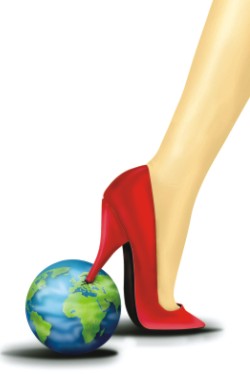
By Nayeema Reza
Illustration: E.R. Ronny
Faria checked her watch and then glanced forlornly at the traffic ahead. The constant whirring of the CNG's engine forced her mind to go into a state of utter frustration. 'I gotta get out of this freaking vehicle!' she cried to herself. Paying the driver, she almost leaped out of the CNG. As she snaked her way through the space between the stationary cars and buses, a sudden blast of thick black smoke spurt out from the rear end of a huge battered bus, blurring her vision and sending her into a coughing fit. Somehow managing to stumble her way to the footpath, Faria blinked several times before she was met by the second unpleasant scene of the day. Staring right across her was a humongous billboard, displaying the ad of some fashion house with a model in it. As if the smoke wasn't a good enough source of pollution, now there were these models and ads causing pollution too (visual pollution to be more precise)! Burying her face in her hands, Faria wondered what else she would have to witness before she went crazy.
Everyday, hundreds of people in our city encounter several different forms of pollution; ones they are completely unaware of. You would be surprised to know that how many of them occur in the name of fashion. Here's a list, check it out.
Visual Pollution
Visual pollution is what our friend, Faria, had come across at the beginning of this article. Sure it's not as unpleasant as the exhaust fumes from cars, but at the end of the day, it is pollution right?
Believe it or not, visual pollution is all around us. If you have ever been through Mirpur Road or any other road for that matter (since they are almost everywhere!), you must have noticed all those gigantic commercials of different boutiques. These advertisements are rather large, taking up whatever view we have left of the sky. Besides that, the view of so many billboards cluttered together isn't really a picturesque one.
Another branch of visual pollution would be bad fashion. That day when I went to this wedding, I was almost 'dazzled' by this saree that a lady was wearing. It seemed as though all the colours that existed in this wide world had been splashed onto her clothes and somehow, the stars had magically fallen off the sky and landed on her multicolored Saree (I could have gone blind!). The problem is that most people these days judge the 'suitability' of a specific outfit by its price tag. What they should do is buy a mirror and take a look at the reflection! It would spare us all of the torture.
On the other hand, if 'Aunties' these days are damaging our eyesight, then so are the teenagers. 'Cool dudes' showing off their underpants and 'hot chicks' donning on low neck, backless (bottom-less and God knows what else could get less!) outfits are not a welcome sight either.
Cultural Pollution
It's during Eid, or any other special occasion, when you can witness cultural pollution at its best. Shops seem to overflow with dresses having names of Indian movies or Hindi serials that have gained popularity throughout the year. 'Devdas Saree', 'Om Shaanti Om dress' (for EID??!), 'Tulsi Saree', 'Anarkali Kameez' all become the 'in' thing to wear for the season. While most of these attires are brought in from India, others are actually made in our very own country. When asked a shopkeeper from Chandnichawk about where in our country were these dresses, he answered in whispered tone, “Amader puran Dhakay karkhana ase'. It's a shame that clothes made in our own country are being sold as those made in India or Pakistan, just because the demand of imported clothes are higher.
Environmental Pollution
Most of the garments or dyeing factories are located on the outskirts of the city. These factories not only pollute the air by releasing smoke into the environment, they taint our waters too. By dumping their wastes or by-products (such as dyes) in the rivers, they stand as a potential threat. Now you might think that if dyes are unloaded into rivers, they might not do much except for turn any person bathing in it into a different color (now imagine a red man emerging from the water. Wouldn't that be a site!).
However, these dyes are more dangerous than any of us suspect it to be. Toxic chemicals sometimes found in the dyeing process include: Dioxin a carcinogen and possible hormone disrupter; Toxic heavy metals such as chrome, copper, and zinc known carcinogens; Formaldehyde a suspected carcinogen. This might cause the water to be 'bright green one day and yellow the next'. The healthiest and safest options are un-dyed natural colored clothes. These are safe for both the skin and the environment.
As you can see, our need to look the best is actually making our mother earth look quite the worse for wear. While we cannot completely give up on our need to be fashionable, we can at least consciously use products that do not harm us or the planet we live in.

